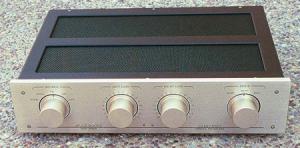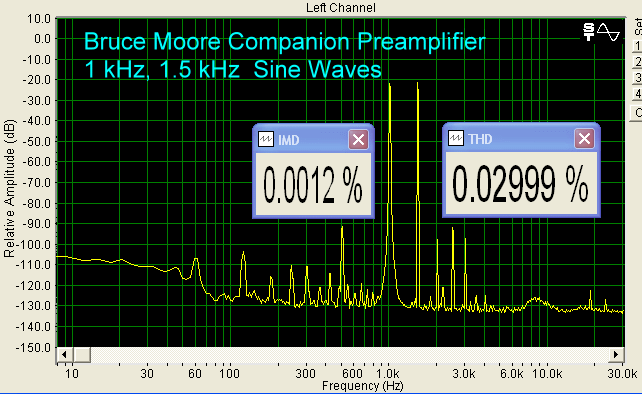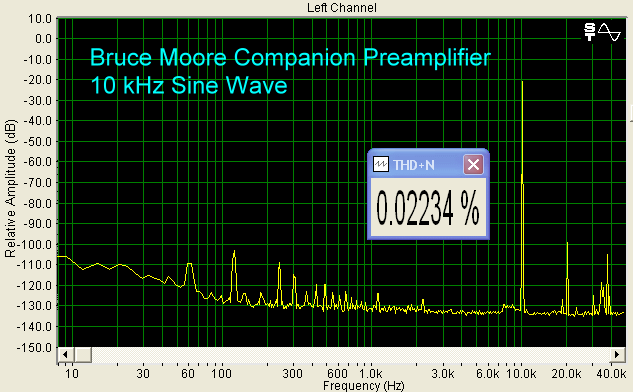|
|

|
|
Specifications:
● Gain: 23 dB
● 5 Line Inputs, Main Out and Tape Out
● Frequency Response: 1 Hz to 500 kHz +0,
-1dB
● Maximum Output: 25V RMS
● THD: < .03% @ 2V RMS Out
● Input Impedance: 75K Ohm
● Output Impedance: 500 Ohms
● Noise: -98dB below 2V RMS output
● Absolute Phase: Non-Inverting
● Tube Complement: Three 6DJ8/6922, Two
12AU7
● Power Consumption: 30 watts (detachable
line cord)
● Dimensions: height = 3.6" (79 mm), width =
16" (381mm), depth = 12" (241mm)
● Shipping Weight: 20 lbs.
● MSRP: $3300 -$3700 depending upon
configuration
Distributed by RB Electronics
www.rbaudio.com
|
Introduction
I have spent many years experimenting with and enjoying Bruce Moore
Electronics. My first encounter was with the Companion II preamp, which I
reviewed at Secrets many moons ago. Then came the Dual 70 amp, also reviewed. Each of
these components was eventually traded in for higher quality products,
resulting in my current pairing of a maximally upgraded Bruce Moore
Companion III preamp (very much in production) with a Dual 100 power amp
(currently out of production).
Since the original Bruce Moore Companion III and Dual 100 entered my system,
a series of upgrades has left the sound far more revealing. My Talon Khorus
X speakers have gone through two major upgrades, resulting in far more open and
extended sound, as well as far more clarity in the lower midrange;
interconnects and speaker cables are the superb Nordost Valhalla; and power
cables, save for a Shunyata Python on the transport, are either Elrod EPS-2
or EPS–3, with a superb EPS Signature-2 power cable on the preamp. (I will
soon have a second Signature-2 for the transport).
I have also done much
experimentation with different tubes for the amp and preamp, striving to
find the most compatible combination for my particular component
configuration (more on this later). Each upgrade has allowed me to hear
further into the heart of recordings, making it easier to determine an
individual component's strength and weaknesses.
My relationship with Bruce Moore Electronics' main distributor, Bob Bergner is a most unusual one. Ordinarily,
some
reviewers make it a point to have minimal contact with manufacturers and
distributors once a product is in their hands. Though some reviewers may
invite manufacturers to their homes to insure optimal set-up, others allow
absolutely no exchange of information until a review is completed. If the
product arrives defective, and the problem lies with the manufacturer rather
than the delivery service, the review is written with a defective piece of
equipment. (If a manufacturer can't get it together to send a fully
functioning unit to a reviewer, what can the consumer expect in way of
quality assurance)? Only after a review is completed is the manufacturer
granted the ability to see the review and offer comments.
In my case, however, since my ability to accurately review components and
music depends upon the reliability and accuracy of Bruce Moore Electronics,
I have consistently engaged in dialogue with Bergner and, by extension, the
reclusive Bruce Moore, as to ways to improve the products. This has resulted
to significant upgrades to aspects of the original Companion III design.
Since beginning the Companion III upgrade process, three other preamps have
arrived for review chez Serinus. Though each costs more than the Companion
III, they have provided the opportunity to more clearly assess the strengths
of Moore's creation.
The Design
The Companion III, totally configured for RCA (single-ended) inputs and
outputs, comes with one main output set, a tape output, two CD inputs, tuner
input, tape input, and auxiliary input. There are two attenuators (volume
controls), one for
each channel; an input selection control; and an off-mute-on control.
Because there is no built-in delay between off to mute to on, purchasers are
counseled to wait three minutes before switching to the on position.
Tubes are two 6922s, two 12AU7s, and a fifth 6922 for the power supply. All
tubes save the power tube are operated in triode mode. This means that only
1/2 the tube is in use at any given time. When a tube shows signs of wear,
it can be moved to the other channel, which utilizes its other half. This
results in tubes lasting twice as long.
I plug all my components, except for the power amplifier, into a Multiwave I-equipped PS Audio
P600 Power Plant. Some tube components do not work well with Multiwave I.
This is not a problem with Bruce Moore gear; it works fine on all Multiwave
I settings. As I write this review, I anticipate the arrival of Multiwave
II, whose new tubewave setting is reportedly compatible with all tube gear.
It will be interesting to discover if it at all alters the sound of the
Companion III preamp.
Preamp Models and Upgrades
The entry-level Companion III ($3300) comes equipped with Arn Rotocap Gold
Point shunt attenuators (specially designed for the Companion III),
Roederstein resistors, and Solan capacitors. Tubes are Tesla 6922s and
Chinese 12AU7s, with a NOS (New Old Stock) Jan Philips 6922 in the power supply.
When I discovered the entry level unit lacking in transparency and detail, and
found the highs a bit splattered and edgy, I first began to experiment with
other tubes. For the longest time, I used a combination of NOS Siemens CCA
Gold pin tubes in place of the Tesla 6922s, and NOS Telefunken ECC 82/12AU7s
smooth plate in place of the Chinese 12AU7s. While this certainly smoothed
and sweetened highs, increased midrange weight, and demonstrably extended
the bass, it did not fully resolve issues of transparency and
three-dimensionality. Highs still lacked refinement, the image was too
opaque for my taste, and there was a stolid one-dimensionality to the
experience. What I heard was still pleasing, yet the inescapable
feeling that I was listening to bit-bound recorded music lessened pleasure.
I found myself spending more time at live performances, and less time with
my system.

After much dialogue with Bergner and Arn Rotocap, the attenuators were first
upgraded to series, and, a year later, to ladder. With each change, the
quality and extension of highs, as well as transparency, depth, and accuracy
of image markedly improved.
I also had the attenuators recalibrated to meet my needs. Regardless of
attenuator type, each initially adjusted volume in 3 dB increments. I
frequently could not get the volume right; it was either too loud or too
soft, especially on jazz, rock, and pop. While I could play classical music
at low volume late at night, even the attenuators' first setting was too
high to play pop music or use my FM tuner after my neighbors had gone to bed. There
were times when I'd listen to the radio on only one channel, hoping my
neighbors wouldn't be disturbed. (This is a common problem with such
attenuators. Even after my friend Joey had the attenuators on his Audible
Illusions Modulus 3 preamp recalibrated to allow finer adjustments, the unit
would play either too loud or too soft. Joey eventually traded the Modulus 3
in for a Companion II-C equipped with specially calibrated Gold Point series
attenuators that had originally been designed for my Companion III. He is
much happier; the sound, albeit not as full as the Modulus 3a, is far more
refined).
I therefore had my attenuators redesigned to permit 2 dB increments in the
critical listening range. The first increments are now set low enough to
allow playing any kind of music at a comfortable level either day or night.
I am also far more capable of matching volume levels between preamps here
for comparison.
After all that was said and done, attendance at shows and visits to fellow
audiophiles' homes enabled me to hear things on favored recordings I still
could not hear chez Serinus. The clincher was a visit by local designer
Alexander Peychev, who brought over his own preamp/DAC design. Hearing
Alex's achievement further convinced me that I needed a preamp capable of
higher resolution and greater transparency.
This resulted in months more dialogue with Bergner, any number of gray
hairs, and some major resistor/capacitor upgrades. All critical resistors
were changed from Roederstein to either Caddock or IRC, and major capacitors
were changed from Solen to Auri-Caps. (Resistors and capacitors in the power
supply remained unchanged, since these were not considered critical to the
sound).
The preamp's price range reflects the range of options available. The basic $3300
unit comes with shunt attenuators, Tesla 6922s, Chinese 12 AU7s, and a Jan
Philips 6922 in the power supply; it also features Roederstein resistors
throughout and Solen capacitors in key places. Series attenuators, which
help to further extend and fill out the highs, cost somewhere in between.
For $3700, you get ladder attenuators, Electro-Harmonix gold pin 6922s, and
Jan Philips 5814s, with a third E-H gold pin 6922 in the power supply; in
critical places, you'll find Caddock and IRC resistors, as well as Auri-Caps.
I unequivocally recommend that anyone drawn to the Companion III's many
virtues spring for the ladder attenuator version. For $400 over the base
price, this Companion III fully realizes the strengths of Moore's design.
Note: One of the Companion III's CD inputs comes hard-wired with an extra
resistor to soften the sound of bright, edgy digital electronics. After
discovering that the resistor accomplished its objective by making the sound
softer, darker, less detailed, and far more opaque, I had the resistor
removed. I advise any purchaser who does not own early, harsh-sounding
digital components to do the same, so that both CD inputs are capable of
producing the same quality sound. This is essential for those with separate
CD, SACD, and/or DVD-A set-ups.
Listening
As with all tube gear, the sound of the Companion III is tube-brand-dependent. Though I have listened to this preamp in its various
configurations for over two years, the recent arrival of Electro-Harmonix
gold pin 6922s (recommended to Bergner by Genesis' Arnie Nudell at HE 2003)
and Jan Philips 5814s has presented the opportunity for some fresh
observations.
Here are notes I took while listening to three wonderful recordings:
1. Terry Evans' “Blues No More” from Puttin' It Down (JVC XRCD):
Using Jan Philips 5814: Quite open and alive on top. Very transparent, clean
attack, fast transient response, highs leaping out at me. The widest
soundstage I've ever heard with this preamp. The cymbals are bright and
alive, perhaps a little too bright, without being steely/aggressive. These
tubes certainly reveal the slightly steely quality of the Talon Khorus X
tweeter and super tweeter. On the one hand, I wish the sound were a bit
mellower. But what I hear is so alive and revealing that I am hooked. This
is the best my system has sounded with this preamp.
Using Telefunken smooth plate ECC 82/12AU7s: Mellower, with a warmer, less
brash sound, but less transparent. Highs seem less extended and open. While
not in the least bit fatiguing, it is a bit gray and laid back.
2. Songs of the Auvergne (CBC Records)
Everyone who has heard this recording has commented on its quality. A chamber music
reduction of Canteloube's original orchestral arrangements, it features
playing so light and colorful, and singing so exquisite as to rate as my
favorite vocal recording of the year. I took this recording from room to
room at HE 2003. While the highs are not as drop-dead delicious as on the
$30,000 Tenor Audio amps, Philips 1000 CD player modified with Meitner DACS,
and Kharma Mini-Ceramiques – I can't remember whose preamp they were using
– the EH gold pin 6922/Jan Philips 5814 combo is working wonders on it chez Serinus.
2. Rachmaninoff: Symphonic Dances (Reference Recordings)
Critically lauded, especially when reproduced with HDCD (which I don't
have). But with the Companion III in its current state, I'm finally hearing
what all the fuss is about. I'm not hearing all the bass and lower midrange
detail I wish to hear, but in my apartment, given my neighbors, that isn't a
bad thing.
The excellence of the top-of-the-line Companion III comes to the fore when
compared to the Reflection Audio OMI-Quantum, a solid-state preamp which
costs $2500 more than the Companion III when powered from the wall. (The
OMI-Quantum costs $7500 when powered by its optional AC4 power supply. Since
designer Stephen Balliet considers the battery pack essential to the
preamp's optimal operation, I have been listening to it in that mode). The
comparison is in one sense unfair, given the sizeable price difference
between the components. But if we hold the OMI-Quantum as some kind of
ideal, comparing it with the Companion III allows us to hear what an
expenditure of several additional thousand dollars can deliver.
With the OMI-Quantum powered by the AC4, there is no question that it has a
lower noise floor than the Companion III, optimal transparency (no tube or
electrical hum), stronger and better-defined bass (bigger power supply),
more lower midrange information (the bottom of the tone is more filled out),
and an impressive soundstage. On Hilary Hahn's superb recording of the
Brahms Violin Concerto (Sony), the OM1-Quantum provides more lower bass
information both in the orchestral introduction and when the violin enters;
low end inner detail is clearer, the sound of the violin is more filled out,
and the contrast between the first aggressive entry of the violin and its
transition into heart-tugging sweetness is more clearly felt. But the
Companion III's tubes provide a magical liquidity and a touch of additional
sweetness that is quite lovely. This special liquidity and sweetness is
equally apparent on the clarinet and oboe solos which follow the opening
outbursts on the Rachmaninoff; these sound just a bit drier on the OM1.
While I certainly hear more orchestral detail on the OM1-Quantum/AC4, what
the Companion III delivers is quite satisfying.
When all is said and done, the Companion III/EPS Signature-2 combo ($5400)
is a more than credible second to the OM1-Quantum. Both offer a timbral
accuracy and near neutrality missing from the two other tube preamps here
for review, both of which cost considerably more than the Companion III. The
Companion III falls short in lower midrange/deep bass extension and detail –
I wish it had a bigger power supply – but everywhere else, it's a winner.
And it also saves on electricity; the bigger the power supply, the more
electricity you use, especially when components are plugged into a
less-than-efficient PS Audio Power Plant.
On the Bench (JEJ)
With a 1
kHz sine wave input, distortion is low, and the principle component is
even-ordered (second order), with only a small third order component, and
nothing significant beyond that.

IMD, using
1 kHz and 1.5 kHz input signals, is low.

IMD is
again low, using 5 kHz and 6 kHz input signals.

THD is
low, using a 10 kHz input. The peaks near 40 kHz are noise, not harmonics. A
very small harmonic is present at 30 kHz (compare with graph when no signal
is input, shown below).

With 10
kHz and 11 kHz input signals, there is a noticeable IMD peak at 1 kHz and
two at 19 kHz and 21 kHz, although the total amount is still a low value.

There is a
measurable amount of AC ripple from the power supply, as shown by this graph
when the power is on, but no signal is input to the preamplifier. There is
also some high frequency noise at around 40 kHz.

The
measured frequency response is within ± 0.5 dB,
20 Hz - 96 kHz.

Conclusions
The Companion III preamp has been a work in progress for several years. In
its ‘'final” $3700 iteration, it delivers sound many steps beyond the
entry-level Companion III. For a tube unit, it is surprisingly neutral
sounding, with far less of the artificially euphonic sweetness that
characterizes the sound of many tube components. Its bass is fast and solid,
if less than realistic in size, its transient response superb, and its
resolution of harmonic nuance and detail is excellent. Any lover of tube gear
who uses RCA-terminated interconnects owes it to themselves to audition this
unit.
- Jason Serinus -
Associated
Equipment:
Digital Front End:
Theta Gen. 5A single-ended DAC
Perpetual Technologies P-1A with Modwright modified Monolithic Power Supply
Audio Alchemy DDS-Pro transport
Amplification:
Bruce Moore 100W dual mono tube power amp with Electro-Harmonix KT-88 and
Siemens CCA tubes
Preamp:
Bruce Moore Companion III tube preamp
Loudspeakers:
Talon Khorus X speakers (with final modifications)
Cabling:
Digital: Nordost Valhalla interconnects and digital interconnects
Analog: Tara Decade and Nirvana SL-1 to phono preamp
Nordost Valhalla bi-wired speaker cable
Powercables: Shunyata Python, Nordost, AudioPrism Super Natural S2, Elrod
EPS-1, 2, and 3 plus EPS Signature-2.
Accessories: PS Audio P600 Power Plant power synthesizer with MultiWave I
PS Audio Ultimate Outlet; PS Audio Power Ports
Michael Green Deluxe Ultrarack, Basic Racks, room treatment, and Audiopoints
Black Diamond Racing Cones
Inner tube, maple cutting boards, bags of sand
Shakti stone and Shakti On-Lines
Bedini Quadra Beam Ultraclarifier
Audioprism Stoplight and Blacklight,
Sheffield/XLO and Ayre degmagnetiser/break-in discs
Terms and Conditions of Use

|












